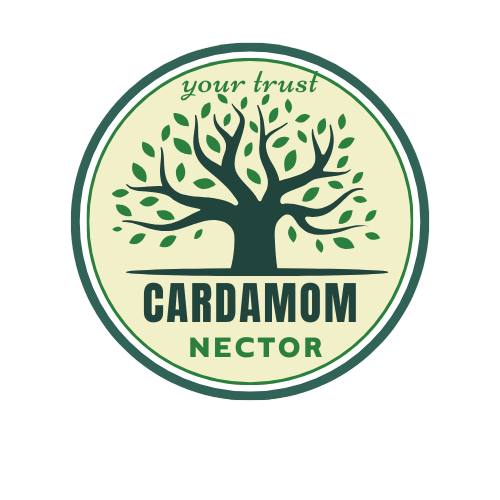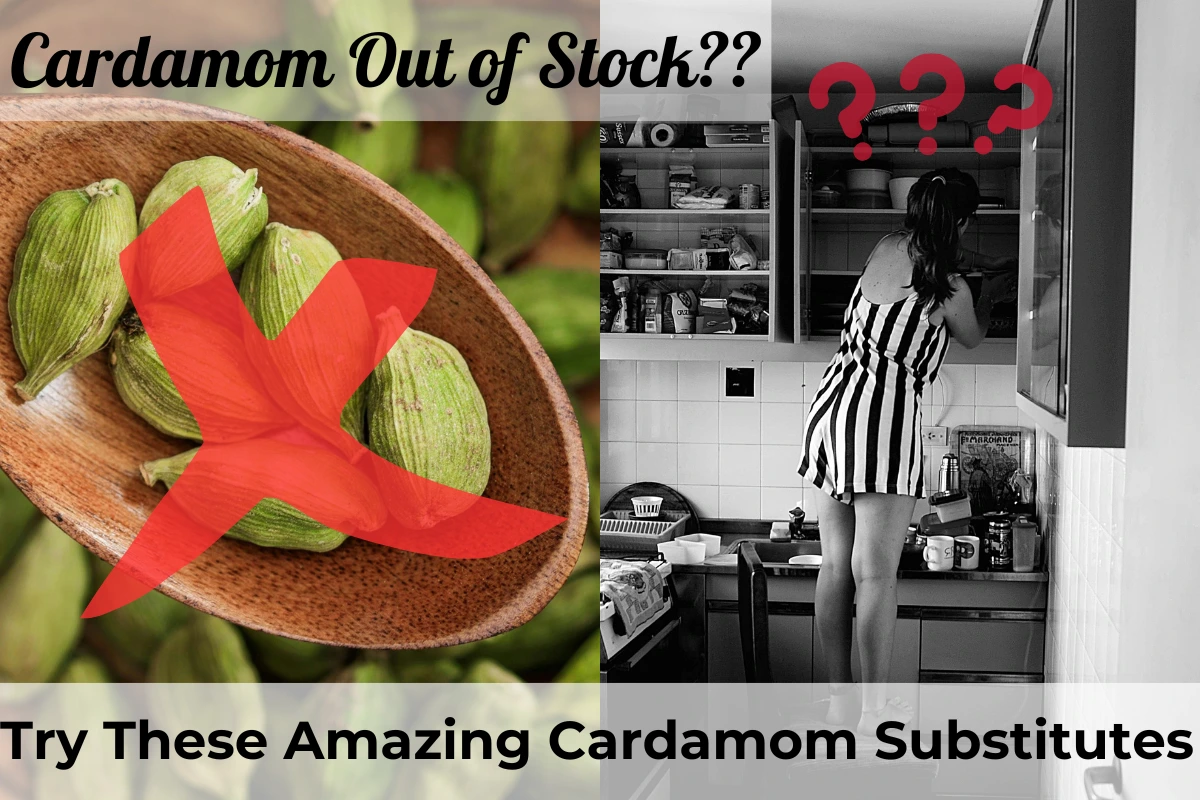Cardamom Out of Stock? Try These Amazing Cardamom Substitutes…
Let’s dive right in! If you’ve ever ventured into the world of spices, you’ve probably come across cardamom—a fragrant, warm, and slightly sweet spice that can elevate a dish from ordinary to extraordinary. But what happens when you find yourself in the Middle of a recipe, excited to use this unique ingredient, only to realize you’re out of cardamom? Don’t worry; I’ve got you covered!
As someone who’s spent years experimenting with flavors in the kitchen, I understand that sometimes you must be creative with your ingredients. Sometimes, disaster strikes when you’re in the Middle of cooking or baking: you’re out of cardamom! Maybe you’ve forgotten to restock, or your local grocery store doesn’t have it in stock. Suddenly, your recipe feels incomplete, and you’re left scrambling for alternatives. Sound familiar? Or maybe you’re just looking for a way to adjust the flavor without having to hunt down the elusive spice.
Don’t worry! I’m here to help. As someone who has spent years perfecting recipes and experimenting with flavors, I understand these frustrating moments. Whether you need a quick solution because you’re in the Middle of curry prep or the Middle of Baking and cardamom, which is nowhere to be found, you’re in the right place.
In this guide, we’ll explore some fantastic cardamom substitutes to help you keep your dish on track without missing out on that cozy, aromatic touch. So, if you’re here because you need a little backup for your recipe, let’s get you set up with the perfect cardamom replacement to save the day!
Table of Contents
Overview of General Substitutes for Cardamom
When you find yourself without cardamom, there’s no need to stress! You can still use several excellent substitutes to achieve that aromatic warmth and depth in your dishes. Here’s a quick overview of some of the most common and versatile cardamom substitutes:
1. Cinnamon and Nutmeg
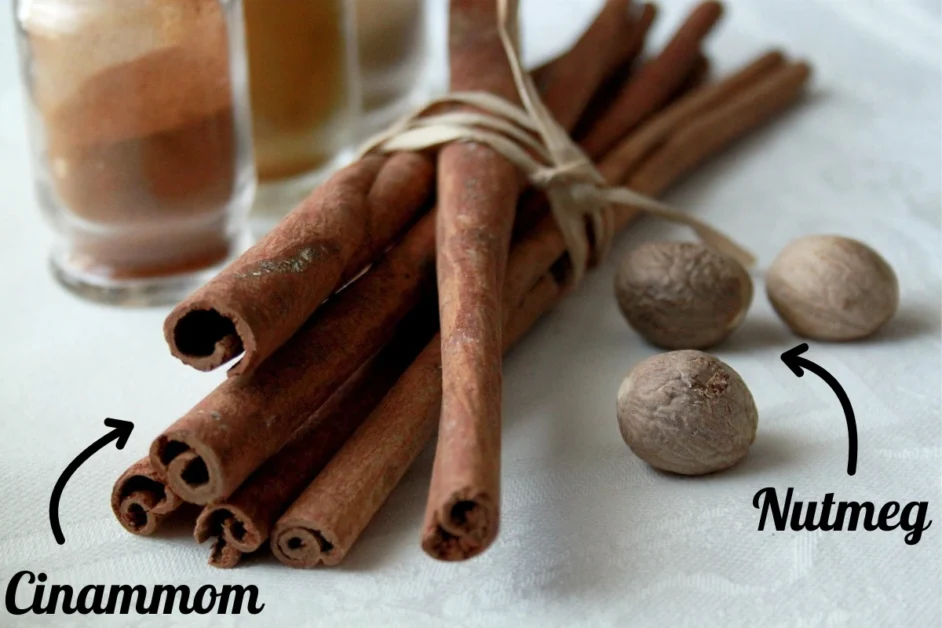
These two spices are staples in many kitchens, and for good reason! Both cinnamon and nutmeg offer a warm, sweet flavor that’s often compared to cardamom. Perfect for baked goods like cakes, cookies, and muffins, they bring that cozy, comforting note to your dishes. If you’re making a sweet treat in a pinch, you can swap in cinnamon or nutmeg (or both) in equal proportions.
2. Allspice
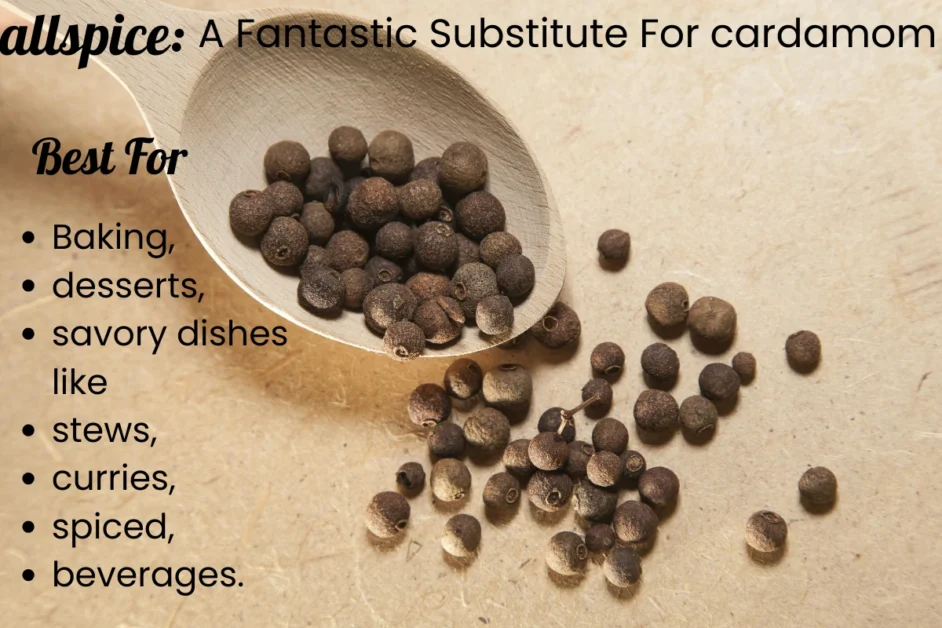
Allspice is a fantastic substitute for cardamom thanks to its unique flavor profile that combines cinnamon’s warmth, nutmeg’s sweetness, and a hint of cloves. This versatile spice is ideal for both sweet and savory recipes. It’s especially great in desserts, pies, and some hearty stews or curries.
3. Ginger
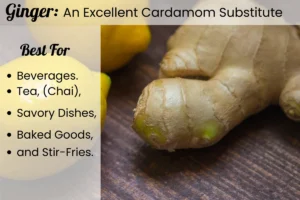
Spicy, aromatic, and with a subtle sweetness, ginger is an excellent alternative to cardamom. Whether Baking cookies or preparing a savory stir-fry, ginger can bring zesty warmth to your dishes. Depending on your recipe and Availability, fresh or ground ginger can be used.
4. Cloves
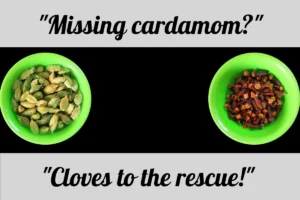
Cloves have a deep, intense warmth that can mimic some of the more robust qualities of cardamom. They work well in aromatic dishes like spiced rice, curries, or marinades. Remember that cloves are firm, so use them sparingly—just a pinch can go a long way!
5. Fennel Seeds
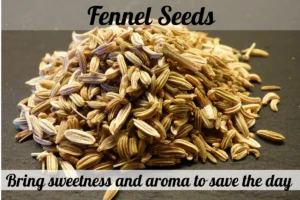
With their slightly sweet, licorice-like flavor, fennel seeds offer a lovely twist when cardamom is missing. They’re especially great for savory dishes, like Indian-style curries or Mediterranean stews. You can also use fennel seeds in baked goods if you want a unique flavor.
6. Anise Seeds
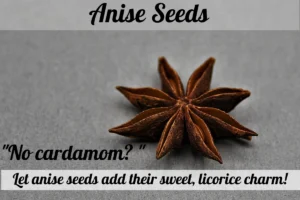
Anise seeds have a distinct licorice flavor, which makes them an excellent option for replacing cardamom in sweet dishes or beverages like chai tea. While they won’t give you the same taste, their warm, sweet notes are an excellent substitute for desserts, cookies, and spiced syrups.
7. Mace

Mace, which comes from the same plant as nutmeg, offers a similar flavor profile but with a slightly lighter and more delicate touch. This spice is a fantastic cardamom alternative in baked goods, custards, and creamy sauces. If you love the flavor of nutmeg, mace will make an excellent substitute for cardamom.
8. Pumpkin Pie Spice
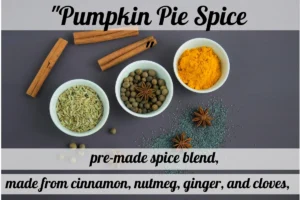
This pre-made spice blend, typically made from cinnamon, nutmeg, ginger, and cloves, is an excellent option when substituting cardamom in Baking. It’s convenient for making autumn-inspired treats like pies, muffins, and cakes. The sweet and spicy mix helps recreate the warmth and complexity of cardamom in your favorite desserts.
9. Coriander
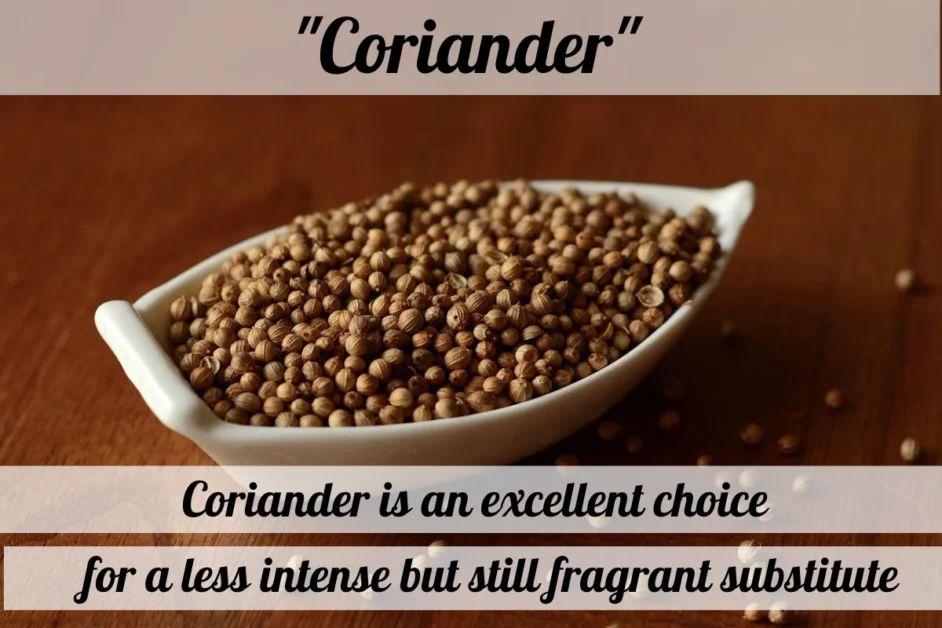
Though less commonly used as a cardamom substitute, coriander can work in some dishes, particularly savory ones. Its mild, citrusy notes can replace cardamom in certain curries, soups, or even baked items where a subtle, fresh flavor is desired. Coriander is an excellent choice for a less intense but still fragrant substitute.
Substitutes for Ground Cardamom vs. Whole Cardamom
When substituting cardamom, it’s essential to recognize the key differences between ground cardamom and whole cardamom pods. While both forms come from the same spice, they have distinct characteristics that affect their use and how they’re replaced in recipes.
For Ground Cardamom
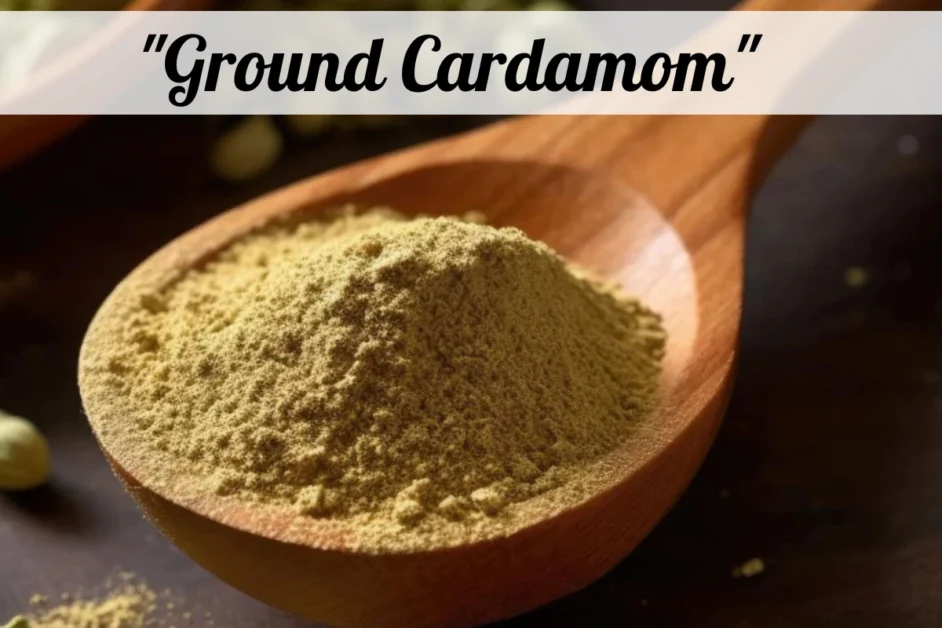
Ground Cardamom is finely milled from the seeds inside the cardamom pods and is best suited for recipes where the spice is added directly to a dish or baked goods. Its fine texture and strong, concentrated flavor make it ideal for desserts, baked goods like cakes and cookies, and beverages like chai. Because it’s already ground, the flavor is quickly released, making it easy to incorporate into recipes. When substituting ground cardamom, it is best to use other ground spices for a similar consistency and quick flavor release.
For Whole Cardamom Pods
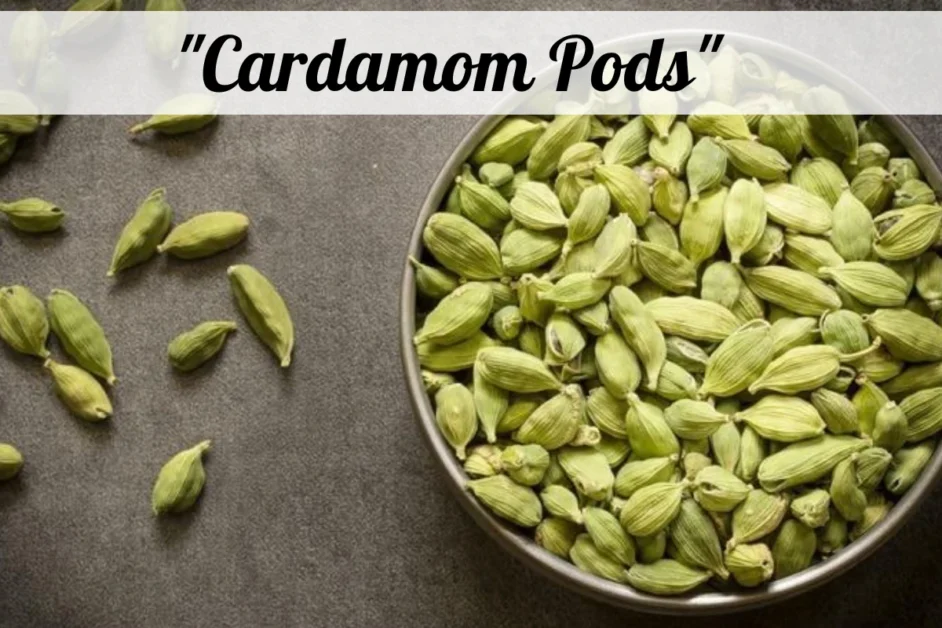
On the other hand, Whole Cardamom Pods are used in savory dishes and are typically added to recipes like curries, rice pilaf, or stews. The whole pods hold their flavor and aroma until cracked open or simmered. The release of their essential oils happens gradually, providing a subtler, more complex flavor profile. Substitutes for whole cardamom often need to be strong enough to match the pods’ flavor and aroma depth. Cumin, cloves, or fennel seeds work well in these savory dishes because they mimic cardamom’s warmth and aromatic qualities.
Key Differences:
- Texture: Ground cardamom has a fine, powdery texture that integrates easily into dishes. In contrast, whole cardamom is often used in its pod form and requires cracking or grinding to release its flavor.
- Aroma: Ground cardamom has an immediate and potent aroma, whereas whole pods release a gentler, more gradual fragrance.
- Flavor Release: Ground cardamom’s flavor is immediately noticeable, while the flavor from whole pods is released more slowly, making it more suited for long-cooked dishes like curries and soups.
Because of these differences, the ground and whole cardamom substitutes are different. Substitutes for ground cardamom need to be similar in form to mimic the fast flavor integration. In contrast, substitutes for whole cardamom need to provide a comparable depth and complexity in more savory contexts.
| Form of Cardamom | Best Substitutes | Best For | Reason for Use |
| Ground Cardamom | Cinnamon, Nutmeg, Allspice, Ginger | , Baked Goods, spiced drinks, marinades Desserts, Beverages | marinades These spices offer a similar warm and sweet flavor profile, and their ground form allows for easy incorporation into sweet recipes |
| Whole Cardamom Pods | Cumin, Cloves, Fennel Seeds, Cinnamon, Black Pepper | Savory Dishes (curries, rice pilaf, stews) Biryani, and Middle Eastern dishes | These spices provide warmth, depth, and aromatic qualities that can substitute for cardamom’s more complex flavor in savory dishes |
Substitutes Based on Dish Type
When you need a cardamom substitute, it’s essential to pick the right one based on the dish you’re preparing. After years of experimenting, I’ve learned that some spices are perfect for baked goods, while others shine in savory dishes or drinks. Let’s look at some of the best substitutes for cardamom based on the type of dish you’re making—and I’ll even throw in a ratio comparison to make things easier!
Best for Baking:
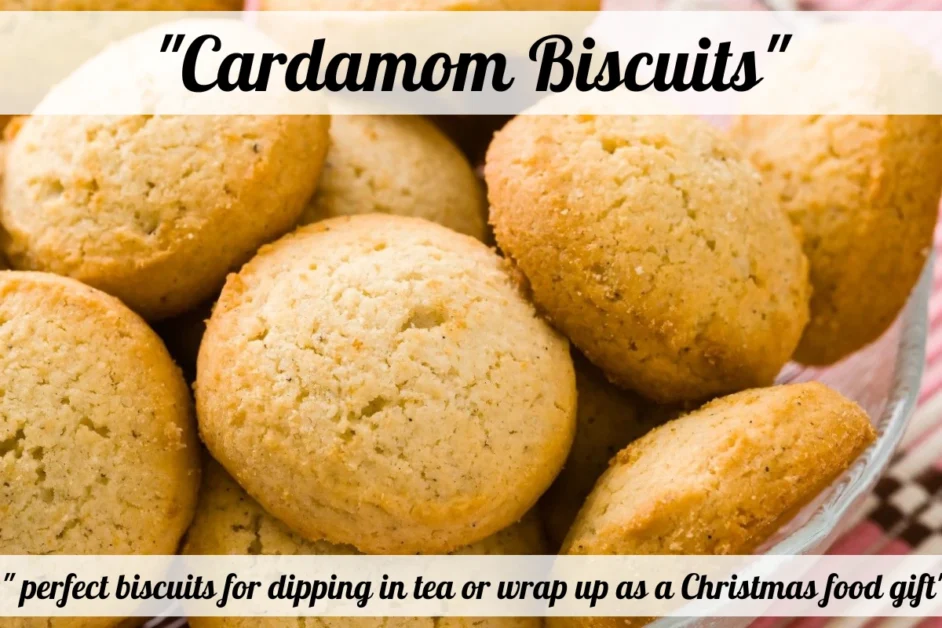
Cardamom shines in Baking, lending warmth and depth to cookies, cakes, and muffins. But if you’re out of cardamom, cinnamon, nutmeg, and Allspice are great go-to’s. They each offer a warm, slightly sweet flavor similar to cardamom and integrate seamlessly into most baked recipes.
- Ratio: Use 1 teaspoon of cinnamon, nutmeg, or Allspice to replace 1 teaspoon of cardamom.
- Best for: Cakes, cookies, muffins, and pastries.
Best for Savory Dishes:
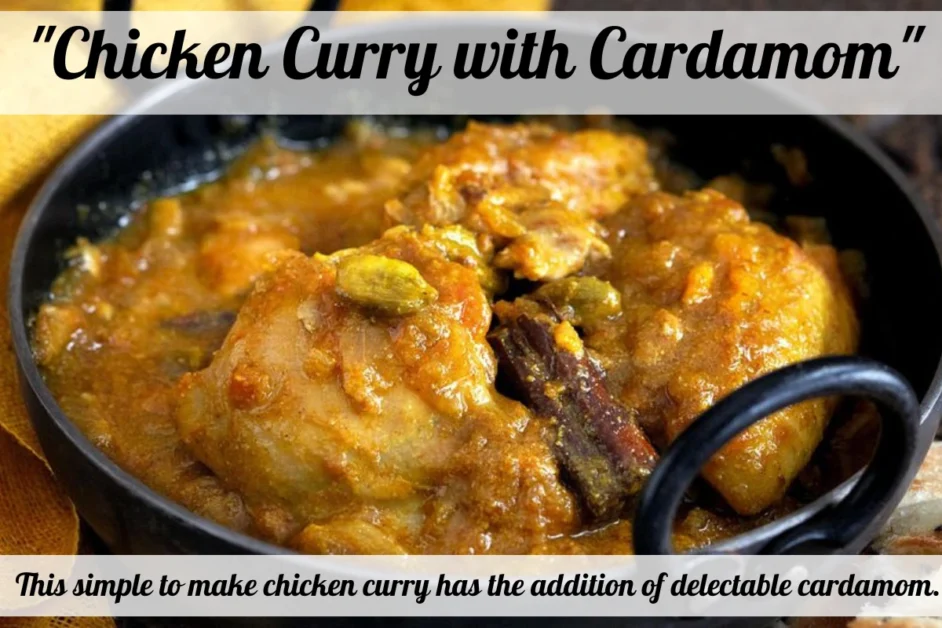
Cardamom is often used in savory dishes like curries, stews, and rice pilaf. If you need a substitute, cloves, cumin, fennel seeds, and coriander can fill perfectly. Each brings a unique flavor that can mimic cardamom’s warmth, complexity, or subtle sweetness.
- Cloves: Use 1/2 teaspoon of ground cloves to replace 1 teaspoon of cardamom.
- Cumin: Use 1 teaspoon of ground cumin to replace 1 teaspoon of cardamom.
- Fennel Seeds: Use 1 teaspoon of fennel seeds to replace 1 teaspoon of cardamom (crush them lightly).
- Coriander: Use 1 teaspoon of ground coriander to replace 1 teaspoon of cardamom.
- Best for: Curries, stews, rice pilaf, and roasted meats.
Best for Beverages:
Cardamom is crucial in providing aromatic sweetness to spiced drinks like chai, mulled wine, or hot toddies. Luckily, ginger, star anise, and cinnamon can easily replace cardamom and bring lovely warmth to your beverages.
- Star Anise: Use a 1-star anise pod to replace one teaspoon of cardamom.
- Ginger: Use 1 teaspoon of ground ginger or 1 small piece of fresh ginger to replace 1 teaspoon of cardamom.
- Cinnamon: Use 1/2 to 1 teaspoon of ground cinnamon to replace 1 teaspoon of cardamom.
- Best for: Chai tea, coffee, mulled wine, and warm spiced drinks.
Best for Desserts:
Cardamom often takes center stage in desserts, adding a floral, slightly spicy sweetness to cakes, cookies, and puddings. If you don’t have cardamom on hand, nutmeg, mace, or fennel seeds are excellent substitutes, each offering a slightly different flavor profile.
- Nutmeg: Use 1/2 teaspoon of ground nutmeg to replace 1 teaspoon of cardamom.
- Mace: Use 1/2 teaspoon of ground mace to replace 1 teaspoon of cardamom.
- Fennel Seeds: Use 1 teaspoon of fennel seeds to replace 1 teaspoon of cardamom (crush them lightly).
- Best for: Cakes, cookies, puddings, and other sweet treats.
These ratios and recommendations will ensure your dishes stay on track, even if you’re missing a little cardamom! Whether baking up a storm, simmering a savory dish, or brewing a warm drink, these substitutes will help you maintain that delightful depth and flavor. Enjoy cooking and experimenting with your new spice swaps!
Substitutes Based on Health and Digestive Benefits
Cardamom isn’t just a flavorful addition to your dishes—it’s also known for its remarkable health benefits, especially regarding digestion. But what if you’re out of cardamom and still want to enjoy those same digestive benefits? Don’t worry! Several spices can help support your digestive system, just like cardamom does. Let me walk you through some fantastic alternatives based on their health benefits.
1.Ginger
When it comes to digestion, ginger is a powerhouse. It’s been used for centuries to relieve nausea, improve digestion, and reduce bloating. Ginger has anti-inflammatory properties and helps to stimulate the production of digestive enzymes, which can soothe an upset stomach and promote healthy digestion. If you’re looking for something that aids digestion and has a warm, spicy kick, ginger is an excellent replacement for cardamom.
- Ratio: Use 1 teaspoon of ground ginger to replace 1 teaspoon of cardamom.
- Best for: Tea, smoothies, baked goods, and savory dishes.
2.Fennel Seeds
Another great option for digestive health is fennel seeds. Fennel has traditionally been used to relieve bloating, gas, and indigestion, making it a wonderful alternative to cardamom in digestive-related dishes. Its slightly sweet, licorice-like flavor works well in both savory and sweet dishes and drinks like herbal teas. Fennel seeds are gentle on the stomach and support overall digestive health.
- Ratio: Use 1 teaspoon of fennel seeds to replace 1 teaspoon of cardamom (lightly crushed).
- Best for: Herbal teas, curries, stews, and roasted vegetables.
3.Cinnamon
Cinnamon is another spice that can aid digestion. It helps regulate blood sugar levels and promotes healthy digestion by improving your body’s ability to digest food. Cinnamon is also known to have anti-inflammatory properties, making it a perfect addition to dishes where cardamom is typically used. While cinnamon doesn’t have the same flavor profile as cardamom, it’s still an excellent option for digestive health.
- Ratio: Use 1 teaspoon of ground cinnamon to replace 1 teaspoon of cardamom.
- Best for: Baking, beverages (like chai or hot cocoa), and savory dishes.
4.Cumin
Cumin is often used in digestive health remedies, and it’s one of my favorites when it comes to spices that help with digestion. It not only helps ease indigestion and bloating, but it also stimulates the production of bile, which aids in digestion. Cumin brings an earthy, warm flavor to savory and sweet dishes, making it an excellent substitute for cardamom in recipes that call for a more robust flavor.
- Ratio: Use 1 teaspoon of ground cumin to replace 1 teaspoon of cardamom.
- Best for: Curries, stews, soups, and roasted meats.
5. Cloves
Cloves are excellent for digestive health as well. They’re known to have antibacterial properties and can help alleviate indigestion and nausea. Cloves also help stimulate the production of digestive enzymes, which aid in breaking down food and improving nutrient absorption. Cloves are a good option if you’re looking for a substitute for cardamom that still offers some of the same aromatic warmth.
- Ratio: Use 1/4 to 1/2 teaspoon of ground cloves to replace 1 teaspoon of cardamom.
- Best for: Curries, rice dishes, stews, and beverages like chai.
These spices aren’t just tasty—they can work wonders for your digestive system like cardamom. Whether you’re looking to soothe your stomach, reduce bloating, or improve your digestion, these substitutes can help keep your digestive health on track. Add them to your daily routine and feel the difference in your digestive comfort!
Substitutes Based on Flavor Profiles and Pairing Suggestions
When substituting cardamom in your recipes, it’s essential to understand how each alternative compares in flavor. Cardamom is known for its unique combination of warmth, sweetness, spiciness, and a hint of citrusy fragrance. But each substitute brings its unique twist to the table. Let’s dive into the flavor profiles of the most common substitutes and see how they stack up against cardamom. Trust me, I’ve worked with these substitutes in countless dishes, and I’m here to share my best tips for pairing them!
Cinnamon & Nutmeg:
These two spices are often the first go-to substitutes for cardamom, and for good reason! Cinnamon and nutmeg share the warm, sweet undertones synonymous with cardamom. Cinnamon has a cozy, sweet-spicy flavor, while nutmeg adds a subtle nuttiness and a hint of warmth and sweetness. Nutmeg is a little more delicate than cinnamon, which makes it an excellent choice for desserts and baked goods where you want a lighter, more fragrant touch.
- Pairings: Cinnamon pairs beautifully with apples, pumpkin, and chocolate, while nutmeg shines in creamy desserts like custards, pies, and spiced drinks. Both work well with baked goods, warm drinks like chai, and savory dishes like curries and stews.
- Best for: Baking, desserts, beverages, and warm spiced dishes.
Allspice:
If you’re looking for a spice that closely mimics the complex, spicy-sweet flavor of cardamom, look no further than Allspice. It has a bit of everything—warmth, sweetness, and a slight kick of spice. It’s often considered a “one-stop-shop” for spices because it combines the flavors of cinnamon, nutmeg, and cloves. This makes Allspice a great cardamom replacement in both sweet and savory dishes.
- Pairings: Allspice is fantastic in desserts like gingerbread, cakes, and pies. It also pairs wonderfully with rich meats like pork and is an excellent addition to curries or stews.
- Best for: Baking, desserts, savory dishes like stews and curries, and spiced beverages.
Ginger:
If you love a bit more heat and spice, ginger is the substitute to reach for! Ginger is bolder and spicier than cardamom, with a sharp, zesty kick. While cardamom has a gentle warmth, ginger brings a strong, fresh spice that can boost your dish or beverage’s flavor. If you want that extra zing, ginger is an excellent substitute, especially for dishes that need a spicy note to balance sweetness or richness.
- Pairings: Ginger works beautifully with fruit-based desserts, stir-fries, soups, and beverages like ginger tea or chai. It also shines in savory dishes like Asian-inspired curries or seafood.
- It is best for: Beverages (like chai), savory dishes, baked goods, and stir-fries.
Cloves:
Cloves have an intense, bold, and aromatic flavor that’s warm and slightly sweet, making them a powerful substitute for cardamom. They have a deeper, more pronounced flavor with a touch of bitterness, which makes them ideal for dishes where cardamom is meant to provide a strong, aromatic depth. Cloves can easily stand in for cardamom in both savory and sweet applications.
- Pairings: Cloves are excellent in hearty stews, curries, and rice dishes, as well as in baked goods like spiced cakes or cookies. They also pair well with meats like ham, lamb, or roast chicken and add a punch to mulled wine or hot cider.
- Best for: Savory dishes, beverages like mulled wine, and baked goods.
Fennel & Anise:
Fennel seeds and anise bring a sweet, licorice-like flavor that can be a surprisingly good alternative to cardamom, especially in desserts or sweet beverages. While they lack the warmth that cardamom brings, they have a lovely, aromatic quality with a touch of spice perfect for giving your dishes a fresh, sweet twist. Fennel, in particular, adds a more herbal, slightly sweet touch, while anise is more assertive with its licorice-like flavor.
- Pairings: Fennel seeds work well in fruit-based desserts, baked goods, and savory dishes like salads or roasted vegetables. Anise is best in baked goods, spiced drinks, or Mediterranean and Middle Eastern dishes.
- Best for: Desserts, beverages (like herbal teas or spiced drinks), and roasted vegetables.
Flavor Comparison Summary:
| Substitute | Warmth | Sweetness | Spiciness | Fragrance | Best For |
| Cinnamon | Medium | High | Medium | Sweet & warm | Baking, desserts, beverages |
| Nutmeg | Medium | Medium | Low | Warm & nutty | Desserts, beverages, savory dishes |
| Allspice | High | High | Medium | Spicy-sweet | Baking, savory dishes, beverages |
| Ginger | High | Medium | High | Fresh & spicy | Beverages, savory dishes, Baking |
| Cloves | High | Medium | High | Bold & aromatic | Stews, curries, baked goods |
| Fennel & Anise | Low | High | Low | Sweet & licorice | Desserts, beverages, roasted dishes |
Understanding the flavor profiles of each substitute helps you make an informed choice. You can easily tailor your dishes with the perfect flavor match, whether you want a more delicate replacement like nutmeg or something with a more potent punch like ginger or cloves.
Best Substitutes Based on Availability
When you’re in the Middle of cooking and realize you’re out of cardamom, the first thing that comes to mind is: What do I have on hand? Well, don’t worry—whether you’re looking for something you already have in your pantry or something special, there’s always a perfect substitute. I’ve been in this situation plenty of times and found that some easy-to-find alternatives work wonders when you’re in a pinch. Let’s break it down based on what’s typically available in most kitchens and what you may need to source from specialty stores.
6 Most Common Household Alternatives Of Cardamom
1.Cinnamon
Ah, cinnamon—this spice is likely in almost every kitchen! Its warm, sweet flavor matches cardamoms, and it can be used in most dishes that call for cardamom. Whether Baking, making chai, or preparing a savory stew, cinnamon is a versatile, easy-to-find substitute.
- Where to Find: Found in almost every pantry, especially in the spice rack.
- It is best for Baking, beverages (like chai and hot chocolate), and savory dishes like stews and curries.
2.Nutmeg
You’re in luck if you already have nutmeg in your spice collection! Nutmeg offers a similar warmth and slight sweetness, though with a hint of nuttiness. It works beautifully in baked goods, desserts, and savory dishes.
- Where to Find: It is commonly found in most kitchens, especially for baking and holiday recipes.
- It is best for Desserts, beverages, and savory dishes like creamy sauces or curries.
3.Allspice
Allspice is often a go-to substitute because it combines the flavors of cinnamon, nutmeg, and cloves. It has a spicy-sweet profile, much like cardamom, and it can easily step in when you’re missing this signature spice.
- Where to Find: Commonly found in the spice section of most grocery stores.
- Best for: Baking, spiced desserts, savory dishes, and beverages.
Specialty Alternatives Of Cardamom
4.Fennel Seeds
Fennel seeds might not always be in your pantry, but if you have them on hand, they make a lovely substitute for cardamom. Their subtle, sweet, licorice-like flavor works especially well in desserts and even savory dishes like curries and roasted vegetables.
- Where to Find: Common in Mediterranean, Middle Eastern, and Indian cuisines, available in most specialty stores or online.
- It is best for: Desserts, savory dishes like curries, and herbal teas.
5.Star Anise
While most people don’t have star anise in their kitchen regularly, it’s a great alternative when you’re looking for something with a similar licorice-like sweetness. It’s wonderful in beverages like chai or mulled wine and can add a beautiful depth of flavor to your dishes.
- Where to Find: Usually available at specialty grocery stores or Asian markets and often found online.
- Best for: Beverages (like chai, tea, or mulled wine) and rich, spiced stews.
6.Mace
If you’ve ever used mace, you’ll know it’s closely related to nutmeg and has a similar flavor profile. Mace is often less common but can be a fantastic substitute for cardamom in certain baked goods or desserts. Its delicate flavor is sweet and warm, making it a great replacement in recipes that need a light, fragrant spice.
- Where to Find: Typically found at specialty spice stores or online.
- Best for: Baked goods, puddings, and spiced desserts.
Here’s a table summarizing the Best Substitutes Based on Availability:
| Substitute | Availability | Flavor Profile | Best For |
|---|---|---|---|
| Cinnamon | Common in most households | Warm, sweet, and slightly spicy | Baking, beverages (chai, hot chocolate), savory dishes (curries, stews) |
| Nutmeg | Common in most households | Warm, sweet, slightly nutty | Desserts, beverages, creamy sauces, curries |
| Allspice | Common in most households | Spicy-sweet combines flavors of cinnamon, nutmeg, and cloves | Baking, spiced desserts, savory dishes, and beverages. |
| Fennel Seeds | Available in specialty stores or online | Sweet, licorice-like flavor | Desserts, curries, roasted vegetables, herbal teas |
| Star Anise | Available in specialty stores or online | Licorice-like, sweet, aromatic | Beverages (chai, mulled wine), spiced stews, rice dishes |
| Mace | Available in specialty stores or online | Warm, sweet, delicate, similar to nutmeg, | Baked goods, desserts, spiced drinks |
This table should help you find the best substitute based on your Availability! Cinnamon, nutmeg, and Allspice are the most accessible substitutes most people have at home, so you can confidently grab them when you’re in a pinch. If you’re feeling adventurous and have access to fennel seeds, star anise, or mace, these more special ingredients can add unique and wonderful twists to your dishes, taking them in an exciting new direction.
Happy cooking! And don’t be afraid to experiment with these substitutes to find your perfect match!
How to Substitute: Quantities and Ratios
When swapping out cardamom for a substitute, it’s essential to keep the ratios in mind so that your dish still has the right balance of flavors. Based on my experience, I’ve put together some guidelines to help you make the perfect substitutions, whether you’re using ground or whole cardamom. Spices can be potent, so using the right amount ensures your dish won’t get overpowered by a substitute but instead enhance the overall flavor profile!
Ground Cardamom Substitution
Since ground cardamom is the most commonly used form, substituting it is quite straightforward. Ground spices are generally easy to replace with other ground versions, and you can stick to the following ratios:
- 1 teaspoon ground cardamom = ½ teaspoon ground cinnamon or ½ teaspoon ground nutmeg
- 1 teaspoon ground cardamom = 1 teaspoon ground allspice
- 1 teaspoon ground cardamom = 1 teaspoon ground ginger (for a spicier kick)
- 1 teaspoon ground cardamom = 1 teaspoon ground cloves (if you’re looking for a more intense, aromatic flavor)
I always recommend starting with these ratios and then tweaking them to taste. You can always add a little more if you want a stronger flavor, but be cautious—some spices (like cloves and ginger) can get intense!
Whole Cardamom Substitution
It’s a different story when dealing with whole cardamom pods. The whole cardamom has a more complex, aromatic release of flavor, especially when cracked open or toasted. Substituting whole cardamom is all about using other whole spices that bring a similar depth. Here’s how to swap them out:
- 1 cardamom pod = 1 star anise pod (great for adding depth to beverages or dishes with a hint of sweetness)
- 1 cardamom pod = 1 teaspoon fennel seeds (if you want a slightly sweet, herbal replacement)
- 1 cardamom pod = 3-4 cloves (perfect if you’re craving a strong, aromatic flavor for savory dishes)
- 1 cardamom pod = 1 teaspoon of cumin seeds (ideal for savory dishes, especially in curries or pilafs)
Remember, whole spices tend to have a more substantial flavor impact when fresh, so if you’re using these whole spice substitutes, be mindful of how much you’re using. You can constantly adjust and taste along the way.
Quick Tip: When substituting whole cardamom in a dish like a curry or pilaf, you can break open the pod and add the seeds directly to your dish. Similarly, you can lightly crush whole spices like cloves or fennel seeds to release their flavors. This method can give you the best results and mimic the complexity that whole cardamom adds to your dish.
Here’s a table to make it easy for you to follow the quantities and ratios when substituting cardamom:
| Substitute | For Ground Cardamom | For Whole Cardamom Pod |
|---|---|---|
| Cinnamon (ground) | ½ teaspoon for 1 teaspoon of cardamom | Not applicable |
| Nutmeg (ground) | ½ teaspoon for 1 teaspoon of cardamom | Not applicable |
| Allspice (ground) | 1 teaspoon for 1 teaspoon of cardamom | Not applicable |
| Ginger (ground) | 1 teaspoon for 1 teaspoon of cardamom | Not applicable |
| Cloves (ground) | ½ teaspoon for 1 teaspoon of cardamom | 3-4 whole cloves for 1 cardamom pod |
| Star Anise (whole) | Not applicable | 1 star anise pod for 1 cardamom pod |
| Fennel Seeds (whole) | Not applicable | 1 teaspoon fennel seeds for 1 cardamom pod |
| Cumin Seeds (whole) | Not applicable | 1 teaspoon cumin seeds for 1 cardamom pod |
| Allspice (whole) | Not applicable | 1 whole allspice for 1 cardamom pod |
This table helps compare the ratios for ground and whole cardamom substitutions. It’s a great reference to have on hand when you’re in a pinch and need a quick solution.
Cardamom Substitute for Drinks
Cardamom stars in many drinks, bringing a warm, aromatic kick to beverages like chai, Turkish coffee, and hot chocolate. However, when you find yourself without cardamom in your pantry, don’t worry—you can still create delicious, spiced drinks with the proper substitutes. Let me share some of my favorite swaps based on the type of drink you’re making. Trust me, with a few tweaks, your drink will still have that perfect, cosy warmth!
Best Substitutes for Tea
When you’re brewing a comforting spiced tea like chai, the absence of cardamom might leave you wondering how to achieve that signature fragrance and flavor. But don’t fret—several fantastic alternatives can still bring that warming, aromatic quality to your tea.
- Ginger: This is a perfect replacement if you love a little heat in your tea. Ginger adds a zesty spice that pairs beautifully with the warmth of other spices like cinnamon or cloves. It’s especially great if you want a bit of a punch in your chai.
- Ratio: Use ½ teaspoon of ground ginger for every 1 teaspoon of ground cardamom.
- Best for: Chai, spiced ginger tea, and other herbal blends.
- Cinnamon: Cinnamon has that same warm, comforting vibe as cardamom, though it’s more pungent and less floral. It will give your tea a cozy, slightly sweet warmth without overpowering the other spices.
- Ratio: Use ½ teaspoon of ground cinnamon for every 1 teaspoon of ground cardamom.
- Best for: Chai tea, cinnamon-spiced teas, and other warm drinks.
- Star Anise: If you’re looking for a more exotic twist, Star Anise can be a great option. It has a distinct licorice-like flavor with a subtle spice, making it perfect for spiced teas. While it doesn’t match the floral profile of cardamom, it’ll still bring a lovely aromatic note.
- Ratio: Use a one-star anise pod for every cardamom pod (or one teaspoon of ground cardamom).
- Best for: Chai tea, mulled wine, and spiced black teas.
Best for Coffee and Hot Beverages
When added to coffee, cardamom brings a rich, slightly sweet fragrance that balances out the deep flavors of the brew. But don’t worry; you can still enjoy a spiced coffee or hot beverage with great substitutes that bring a different but equally wonderful flavor.
- Ground Cloves: Cloves have a deep, aromatic flavor with a slight warmth. While they can be a little intense, they work well in coffee. They’ll add a rich, bold flavor and a touch of sweetness to your cup, mimicking some of the spicy notes that cardamom brings.
- Ratio: Use ¼ teaspoon of ground cloves for every 1 teaspoon of ground cardamom.
- Best for: Coffee, spiced lattes, mulled wine, and other hot beverages.
- Allspice: Allspice is an excellent substitute for coffee because it combines warm, sweet, and slightly spicy notes. It’s milder than cloves, but it still adds signature aromatic warmth to your drink.
- Ratio: Use ½ teaspoon of ground allspice for every 1 teaspoon of ground cardamom.
- Best for: Coffee, hot chocolate, spiced cocktails.
Quick Tip for Beverages:
If you’re using a whole spice like star anise or cloves for your beverages, I recommend brewing the spices with the liquid for a few minutes to allow their full flavor to infuse. If you’re using ground spices, start with small amounts and adjust to taste as you go—especially with cloves, which can be potent!
Cost Considerations of Cardamom vs. Substitutes
Cardamom, a wonderfully fragrant and flavorful spice, is notorious for its high price. Whether you’re using green cardamom pods or ground cardamom, it can be one of the more expensive spices on your shopping list, especially if you’re buying the whole pods. The price tends to fluctuate depending on factors like origin, quality, and Availability, making it a bit tricky to keep stocked in your kitchen if you’re on a budget.
However, you don’t have to compromise on flavor. Many cost-effective substitutes can give you similar warmth, spice, and sweetness without breaking the bank. Let’s discuss the cost of cardamom and some affordable alternatives that will work wonders in your dishes and drinks.
Cardamom Price vs. Substitutes
The cost of cardamom is high due to its labor-intensive harvest process, which is growing primarily in limited regions. Meanwhile, spices like cinnamon and cloves are much more affordable and available year-round. Let’s break down the price differences so you can make the best choice based on your budget:
Cost Comparison Table
| Spice | Price per ounce (Approx.) | Notes |
|---|---|---|
| Cardamom (green pods) | $3.50 – $5.00 | High-quality cardamom can be pricey, especially whole pods. |
| Ground Cardamom | $2.00 – $3.50 | It is still relatively expensive compared to other spices. |
| Cinnamon (ground) | $0.75 – $1.50 | Widely available and affordable year-round. |
| Cloves (whole) . | $1.00 – $1.50 | Affordable and has a strong, aromatic flavor |
| Nutmeg (ground) | $1.00 – $1.50 | Adds a warm spice, but not as sweet or floral as cardamom. |
| Allspice (ground) | $1.00 – $2.00 | An excellent substitute for sweet and savory dishes. |
| Ginger (ground) | $1.00 – $1.50 | Spicy and aromatic, an affordable option for many recipes. |
| Fennel Seeds | $1.00 – $1.75 | Great for savory dishes and desserts with a mild, licorice-like sweetness. |
Affordable Alternatives to Cardamom
If you’re looking for affordable substitutes, here are a few options that will deliver similar warmth, spice, and even a bit of sweetness without putting a strain on your wallet:
- Cinnamon: Cinnamon is one of the most affordable and readily available spices, making it a fantastic substitute for baked goods and spiced beverages. While it lacks cardamom’s distinct floral note, it does bring a comforting warmth and sweetness to dishes.
- Cloves: Cloves are slightly more potent than cardamom but are an excellent option for savory dishes or beverages like chai. They can bring that aromatic, spicy kick, making them a solid, budget-friendly choice.
- Nutmeg: While not exactly like cardamom, nutmeg provides a warm, slightly sweet, and nutty flavor that works well in desserts and even some savory recipes. It’s an excellent alternative when you’re looking for something similar but a little more economical.
- Allspice: Allspice has a unique flavor that combines the heat of cloves, the sweetness of cinnamon, and the warmth of nutmeg, making it a very close match for cardamom in sweet and savory dishes.
- Ginger: Fresh or ground ginger can offer a zesty and aromatic flavor with a spicy kick. It’s perfect when you need that extra heat, especially for beverages like chai or for adding spice to savory dishes.
Quick Tips to Save on Cardamom
- Buy in Bulk: If you use cardamom frequently, buying it in bulk can help lower the cost per ounce.
- Use Cardamom Pods: Buy whole cardamom pods rather than pre-ground cardamom. Grinding it yourself as needed can often be more cost-effective and keep the spice fresh.
- Opt for Substitutes: When cardamom is not the dish’s star, using one of the more affordable substitutes (like cinnamon or cloves) can give you a similar warm spice at a fraction of the cost.
Storage of Cardamom and Substitutes
When storing cardamom and its substitutes, we want to ensure that they maintain their rich flavors and aromas. However, a few common problems often arise when storing spices, and I’ve got some tips to help you avoid them!
Exposure to Air and Moisture
One of the most significant issues with storing cardamom and other spices is exposure to air and moisture. If left unsealed, your cardamom pods or ground cardamom can dry out, losing the essential oils that give them their delightful fragrance. Ground spices are especially vulnerable to this, as they tend to lose their freshness much faster than whole spices.
Solution & Tip: To preserve the potency of your cardamom and its substitutes, always store them in airtight containers. Glass jars, vacuum-sealed bags, or tightly sealed spice containers will protect your spices from air and moisture. This simple step will help keep the natural oils intact, ensuring your spices remain flavorful and aromatic for longer.
Exposure to Heat and Light
Another issue is keeping your cardamom and substitutes in areas exposed to heat or light. Both heat and sunlight can break down the compounds in your spices, leading to a significant loss in flavor and aroma. I know it’s tempting to keep them on the countertop or near the stove for easy access, but that can shorten their shelf life considerably.
Solution & Tip: Store your spices in a cool, dry, and dark place—away from heat sources like the oven, stove, or direct sunlight. A spice drawer or pantry works perfectly for this. Just ensure the space is stable in temperature, and avoid areas that experience moisture or humidity.
Ground Spices Losing Freshness Quickly
Ground cardamom is convenient but can lose flavor faster than whole cardamom pods. Over time, the essential oils contributing to its aromatic and floral taste evaporate, leaving behind a dull, less flavorful spice.
Solution & Tip: To keep cardamom’s full, vibrant flavor, consider buying it in whole pod form. Entire cardamom pods retain their oils for much longer than ground cardamom. When you need the spice, crush or grind the pods as needed, this will keep your cardamom fresh and full of flavor much longer. If you’ve already got ground cardamom, use it within six months for the best results.
Strong Odor Absorption
Spices are aromatic, and they can easily absorb surrounding smells. This becomes problematic when storing cardamom or other spices near strong-smelling foods like garlic, onions, or coffee. Once your spices absorb these odors, their delicate flavor can be compromised.
Solution & Tip: To prevent this, store your spices in a separate part of your pantry, away from pungent foods. If you’re worried about odor absorption, use sealed bags inside your spice containers for extra protection. This will ensure that the spices remain true to their original flavor profile without picking up unwanted smells from your kitchen.
Stale or Moldy Spices from Long-Term Storage
Sometimes, we forget about the spices hiding at the back of the pantry, and they sit around for much too long. Stale or moldy spices can develop over time if stored improperly, especially if exposed to moisture or excessive heat.
Solution & Tip: Label your spice containers with the date of purchase so you know how old they are. Use older spices first and avoid keeping them in storage for too long. For longer-lasting freshness, you can also freeze your spices (both whole and ground). Just be sure to store them in airtight bags or containers before freezing. When you need to use them, take them out and let them come to room temperature before opening.
Dealing with Less Frequent Use of Spices
If you don’t use cardamom or its substitutes often, you might find yourself with a spice jar sitting untouched for months. Over time, these spices can lose their flavor or even become stale.
Solution & Tip: To avoid wasting spice, buy smaller quantities or purchase from bulk bins so you can buy just what you need. This helps keep your spices fresh and ensures you use them at their peak flavor. If you need to store them for extended periods, consider sealing them in airtight containers and keeping them in a cool, dark place to maintain their flavor as much as possible.
Conclusion
by wrapping it up, cardamom substitutes are a great way to keep your cooking flavorful, even if you don’t have cardamom on hand. You can still create delicious dishes, whether you choose spices like cinnamon, ginger, or nutmeg or go for a blend like chai masala. While no substitute can match cardamom’s unique taste, many of these alternatives bring similar warmth and depth to your recipes. With some know-how, you can keep your meals tasty and full of flavor, even without the real deal!
